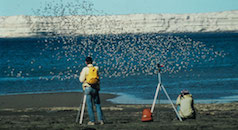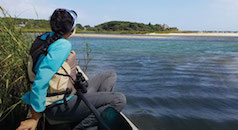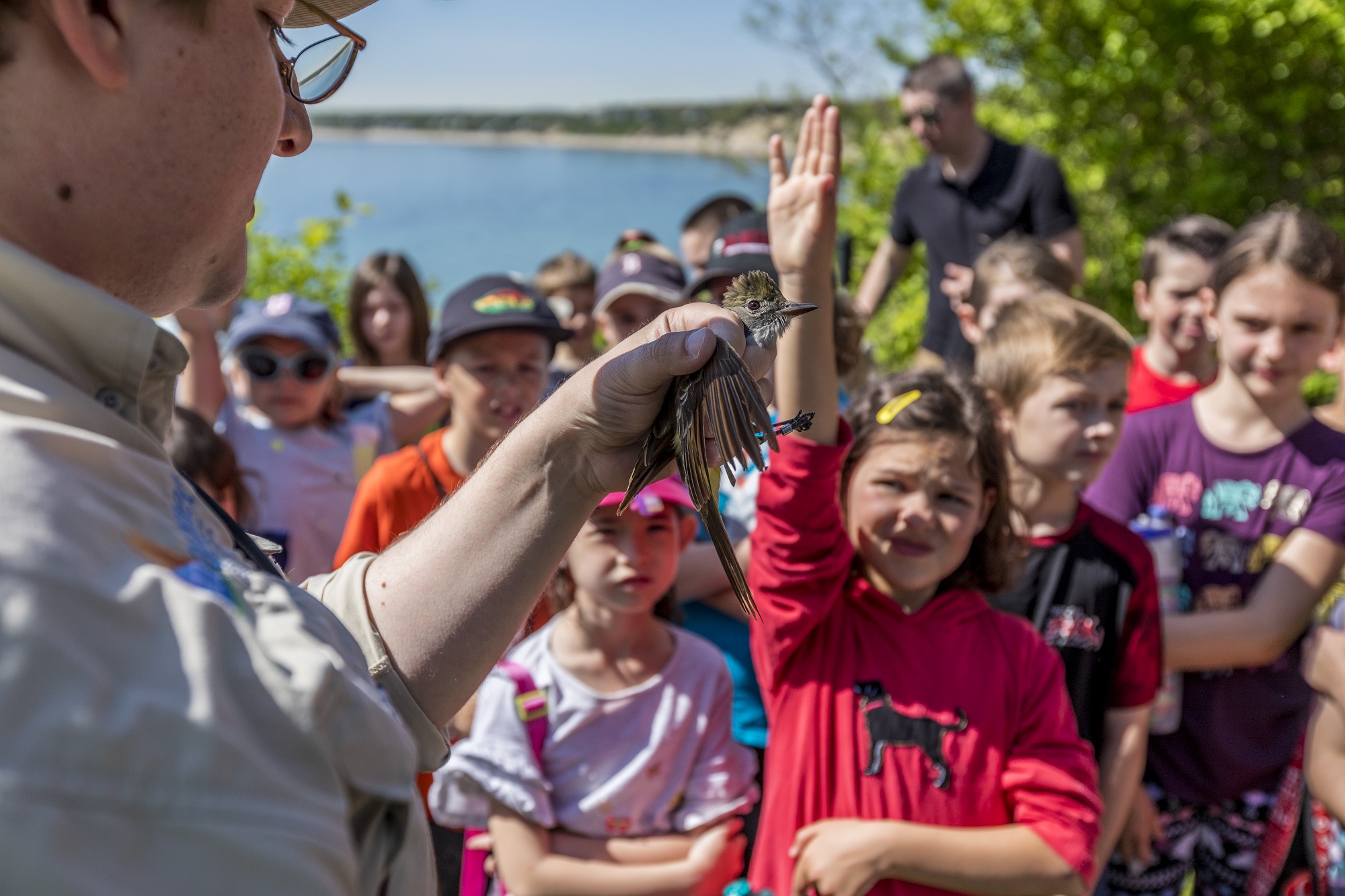Search Results

Saving horseshoe crabs…one company at a time
From the Lab: Good News for Horseshoe Crabs and Shorebirds The biggest news story from the Delaware Bay this year is not the high counts of Red Knots and good departure weights, although those are both very exciting and welcome pieces of news. The biggest (and also extremely welcome) news came on May 10th, just as horseshoe crab numbers were increasing on the beaches and before most birds had even arrived. Before we get to the good news, let’s take a step back and look at the horseshoe crab. Atlantic horseshoe crabs are found from Maine to Mexico, with three other species found in Asia. Formerly abundant, horseshoe crabs spawn from April to July, packed onto the beaches of inland...
Want to learn more about Manomet and what we do?
Have you been reading about the work that Manomet does and wishing that you could experience it for yourself? Well, you can! We’re wrapping up another great series of Manomet “In the Field” events, with just one trip left for this season. Our spring lineup has been jam-packed with fun, exciting, and rewarding events that have taken Manomet Members behind-the-scenes to experience our mission in action. The Spring 2018 “In the Field” series began at historic Mt. Auburn Cemetery for our annual Spring Warbler Extravaganza where Trevor Lloyd-Evans led our group around the beautiful, rolling terrain in search of migrant songbirds. We saw more than three dozen different species, including a Nashville Warbler, multiple Baltimore Orioles, and a beautiful Scarlet...
Raising the profile of the pesky green crab
More than 75 fishermen, chefs, consumers, regulators, scientists and educators came together in Portland, Maine, earlier this month to talk about how to develop a viable fishery and markets for the invasive green crab. Manomet worked with New Hampshire Sea Grant to convene ‘The Green Crab Working Summit,’ which attracted nationwide attention. The two-day program included speakers from chefs to fishermen to educators to scientists, as well as cooking demonstrations, all focused on how best to mitigate the impacts of this invader. Participants learned about many ongoing projects, including creating markets for soft-shell green crab, green crab roe, and green crab mince, as well as ongoing efforts to expand the green crab bait market (e.g., using green crab bait...
Arctic Shorebird Demographics Network (ASDN)
Recent shorebird trend analyses indicate that many Western Hemisphere shorebird species are declining, but we do not fully understand why. The goal of the Arctic Shorebird Demographics Network (ASDN) is to conduct demographic analyses for several target species that will help determine the factors limiting their populations. The ASDN measures demographic rates like adult survival and productivity and other demographic parameters at various life history stages. The project is designed to substantially increase our ability to address a wide variety of other science and conservation goals that can only be approached at a regional or global level, such as migratory connectivity studies that require work across the entire range of a species.
Santiago Shorebird Workshops
From January 4th-6th, 2018, Manomet’s Habitat Management Division partnered with the University of Santo Tomas, the Centro Bahía Lomas, and the Western Hemisphere Shorebird Reserve Network (WHSRN) to host the first Shorebird Ecology, Conservation, and Habitat Management Workshop of 2018 - in Santiago, Chile. This workshop follows several recent Manomet workshops in South America, including Lagoa do Peixe and Banco dos Cajuais in Brazil in 2016 and Bahía Samborombón and Bahía Blanca in Argentina in 2017. The Santiago workshop was held at the University of Santo Tomas with a field trip to the wetlands at the mouth of the Maipo River, part of the WHSRN site Desembocadura y Estuario del Río Maipo. The 23 workshop participants represented multiple organizations, including the Chilean Ministry of the Environment, the...
Mississippi Shorebird Workshops
Manomet partnered with Delta Wind Birds, a local nonprofit organization promoting shorebird conservation in the Mississippi Alluvial Valley, the US Fish and Wildlife Service, and the Lower Mississippi Valley Joint Venture, to host two shorebird workshops between September 29 and October 2, 2015. Managers of public and private lands from six southeastern states gathered in Lambert and Isola, Mississippi, for workshops highlighting land management to support migrating shorebirds passing through the Mississippi River Valley Alluvial Delta. Presentations and Handouts: Habitats For Shorebirds Informing Habitat Management for Shorebirds in Louisiana USFWS Integrated Waterbird Management and Monitoring Initiative 2014 Annual Report Lower Mississippi Valley Joint Venture: Biological Planning & Conservation Design: Shorebirds Lower Mississippi Valley Joint Venture: Monitoring Shorebirds Wetland Management Decision Making for Multiple Objectives Shorebird...
Conservation Counts – The Story Of The American Oystercatcher
On the southern coast of New England, one of the early indicators of spring is the raucous call of American Oystercatchers newly returned from coastal marshes in the Southeast. For much of the 20th century, these large, colorful shorebirds were absent from the Northeast and restricted to remote areas of the mid-Atlantic coast. Market hunting and egg collecting had decimated their population and Oystercatchers were slow to recover. By the 1970’s and ‘80s, they began to reappear, only to be met with rapid development of coastal areas and an increasing flood of humans competing for the same beaches the Oystercatchers need for nesting. Over the course of this exceptionally cold and stormy winter, I spent many hours staring through binoculars...
McMahan receives two awards for fisheries work
Marissa McMahan, Senior Fisheries Scientist, recently received two prestigious awards for her fisheries research. The Gulf of Maine Research Institute (GMRI) awarded McMahan the 2017 John H. Annala Fishery Leadership Award. This award was established in honor of GMRI’s founding Chief Scientific Officer and recognizes an early career fisheries scientist whose work has the potential to benefit the Gulf of Maine ecosystem and the communities that depend on it. The award states: “For her contribution to understanding changing fish distributions in the Gulf of Maine ecosystem and her commitment to collaboration between scientists and fishermen.” McMahan noted how honored she is to receive the award: “It is particularly meaningful to me because I started my early scientific career at GMRI,...
Fisheries
Manomet’s Fisheries team works to promote resilient and productive coastal ecosystems and communities through applied science and community engagement. Our work focuses on the Gulf of Maine, an area experiencing rapid climate-induced warming and immense ecological and social change. We work in partnership with coastal communities, fishers, and other industry members to co-develop climate change adaptation strategies that build greater social, ecological, and economic resilience.
The Future of Fishing: an extraordinary tasting and learning opportunity on Boston’s Fish Pier
The Gulf of Maine extends from Cape Cod to the Bay of Fundy. It is one of the most productive marine ecosystems on earth. But the Gulf of Maine is warming faster than 99% of the world’s oceans. Some fish species, like northern shrimp, are moving out, and other potentially valuable species, such as black sea bass and dogfish, are moving in. Fishing is fundamental to the New England culture. To sustain this heritage, fishermen, scientists, and even fish consumers will need to adapt to the changing system. So, join us on Boston’s Fish Pier for a special evening of tasting and learning. Meet and talk with fishermen, scientists, chefs, and others who are on the front lines of adapting...



